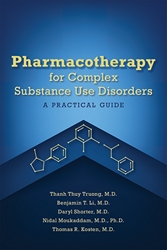Psychodynamic Psychopharmacology
Caring for the Treatment-Resistant Patient
View Pricing
Description
The troubling increase in treatment resistance in psychiatry has many culprits: the rise of biomedical psychiatry and corresponding sidelining of psychodynamic and psychosocial factors; the increased emphasis on treating the symptoms rather than the person; and a greater focus on the electronic medical record rather than the patient, all of which point to a breakdown in the person-centered prescriber–patient relationship.
Psychodynamic Psychopharmacology illuminates a new path forward. It examines the psychological and interpersonal mechanisms of pharmacological treatment resistance, integrating research on evidence-based prescribing processes with psychodynamic insights and skills to enhance treatment outcomes for patients who are difficult to treat.
The first part of the book explores the evidence base that guides how, rather than simply what, to prescribe. It describes precisely what psychodynamic psychopharmacology is and why its emphasis on combining the often-neglected psychosocial aspects of medication with biomedical considerations provides a more optimized approach to addressing treatment resistance.
Part II delves into the psychodynamics that contribute to pharmacological treatment resistance, both when patients' ambivalence about their illness, the medication itself, or their prescriber manifests in nonadherence and when medications support a negative identity or are used as replacements for healthy capacities. Readers will gain basic skills for addressing the psychological and interpersonal dynamics that underpin both scenarios and will be better positioned to ameliorate interferences with the healthy use of medications.
The final section of the book offers detailed technical recommendations for addressing pharmacological treatment resistance. It tackles issues that include countertransference-driven irrational prescribing; primitive dynamics, such as splitting and projective identification; and the overlap between psychopharmacological treatment resistance and the dynamics of treatment nonadherence and nonresponse in integrated and collaborative medical care settings.
By putting the individual patient back at the center of the therapeutic equation, psychodynamic psychopharmacology, as outlined in this book, offers a model that moves beyond compliance and emphasizes instead the alliance between patient and prescriber. In doing so, it empowers patients to become more active contributors in their own recovery.
Contents
- Preface
Part 1. What Is Psychodynamic Psychopharmacology?
- Chapter 1. What Is Psychodynamic Psychopharmacology?
- Chapter 2. Why Psychodynamic Psychopharmacology?
- Chapter 3. What Is Psychodynamic About Psychodynamic Psychopharmacology?
Part 2. Understanding Pharmacological Treatment Resistance
- Chapter 4. Psychodynamics of Pharmacological Treatment Resistance
- Chapter 5. Treatment Resistance to Medications
- Chapter 6. Treatment Resistance From Medications
- Chapter 7. The Prescriber's Contribution to Treatment Resistance
Part 3. The Manual of Psychodynamic Psychopharmacology
- Chapter 8. Avoid a Mind-Body Split
- Chapter 9. Know Who the Patient Is
- Chapter 10. Attend to Patients' Ambivalence
- Chapter 11. Cultivate the Pharmacotherapeutic Alliance
- Chapter 12. Attend to Countertherapeutic Uses of Medications
- Chapter 13. Identify, Contain, and Use Countertransference
- Chapter 14. Who Is Psychodynamic Psychopharmacology For? Patient Characteristics
- Chapter 15. Before Initiating Treatment
- Chapter 16. The Engagement Phase
- Chapter 17. The Maintenance Phase
- Chapter 18. Split and Combined Treatments
- Chapter 19. Psychodynamic Psychopharmacology and Integrated Care
- Appendix 1. Psychodynamic Psychopharmacology Self-Assessment Checklist
- Appendix 2. Glossary of Psychodynamic Concepts Relevant to the Practice of Pharmacotherapy
- Index
About the Authors
David Mintz, M.D., is Director of Psychiatric Education, Associate Director of Training, and a Team Leader at the Austen Riggs Center in Stockbridge, Massachusetts.
Related Products
Carousel Control - items will scroll by tabbing through them, otherwise arrows can be used to scroll one item at a time








